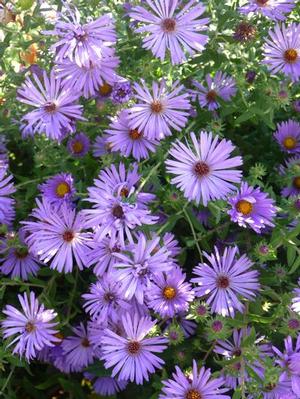New Moon Nurseries

Good for meadows, bird and butterflies, and use as a landscape ornamental. Aromatic aster is drought tolerant.
Aster oblongifolius
Aromatic aster
Native to North America
FIRST IMPRESSIONS: Aster oblongifolius is a bushy mounding perennial. The aromatic leaves are gray green and pubescent. In early autumn, foliage is covered by cheerful lavender daisies. The flowers are larger than other asters and showy with an abundance of petal-like rays. This robust plant is tough and adaptable prospering in sun and drought.
HABITAT & HARDINESS: Aster oblongifolus is most common in the central United States especially the Plains States. Isolated populations occur is many of the Eastern states.
Indigenous plants are most likely to be found in in dry prairies, dolomitic or limestone glades, on rocky bluffs and other sunny sites with dry rocky or gravelly soil.
Plants are hardy from USDA Zones 3-8.
PLANT DESCRIPTION: Aster oblongifolius is a densely branched globe shaped plant that forms small colonies from underground rhizomes.
Stems are stiff and woody at the base with an abundance of foliage. Leaves are oblong and up to 4” long. They are fragrant but only when crushed or disturbed. Like most asters, leaves are much smaller and narrower on the upper stems.
Flower heads consist of many violet blue ray flowers surrounding a cluster of yellow disc flowers. The blooms are produced in profusion for a long period in fall. They are large, showy, prolific and attractive to bees, skippers and butterflies.
Plants grow up to 2-3’ tall with 3’ spread.
CULTURAL & MAINTENANCE NEEDS: Aster oblongifolius grows best in full sun but will tolerate partly shaded areas that have at least a half day of sun. If planted with aggressive taller plants, this aster will decline.
Plants thrive in average to dry conditions and adapt to clay, alkaline and poor rocky soils. Plants tolerate drought. In extremely dry situations, irrigation may be needed to prevent defoliation of lower leaves.
Foliage is somewhat unpalatable to deer and rabbits but occasional nibbling does occur.
LANDSCAPE USES: This is a particularly showy aster that can be used in traditional gardens as a sustainable substitute for fall chrysanthemums. It is a good choice for a Wildlife Garden, Sunny Meadow or Prairie. Plants are also used as Butterfly Nectar Plants, Butterfly Host Plants, Cut Flowers or as part of a Grouping or Mass Planting. Aster oblongifolius has Showy Blooms and can be used in Cottage Gardens, Deer Resistant Plantings, Water-wise Landscapes, Low Maintenance Plantings, Perennial Borders, Roadsides and Restoration Projects.
COMPANION & UNDERSTUDY PLANTS: Try pairing Aster oblongifolius with Eryngium yuccifolium, Rudbeckia subtomentosa, Solidago nemoralis, Liatris aspera, Andropogon gerardii and Schizachyrium scoparium.
Aster novae-angliae or Aster oblongifolius cultivars like ‘October Skies’ and ‘Raydon’s Favorite’ can be substituted if needed.
TRIVIA: Many of the established Latin names of Aster spp. were changed recently due to DNA and genetic research findings. So Aster oblongifolius is now known as Symphyotrichum oblongifolium.
Plants host caterpillars of the Silvery Checkerspot Butterflies and of several moths.
Wild Turkey feeds on the seed.
Compared to other asters, Aster oblongifolius usually has more ray florets (20+) than the norm, larger flower heads that are 1” or more and an unusual dense bushy habit.
Height:
2-3 ftSpread:
1-3 ftUSDA Hardiness Zone:
3-8Bloom Color:
LavenderAster oblongifolius Characteristics
Attracts Wildlife
- Butterflies
- Pollinators
Attributes
- East-Coast Native
- Drought Tolerant
- Dried Flower
- Cut Flower
- Naturalizing
- Clay Soil
- Rain Garden
- Ground Cover
- Fragrant
Exposure
- Full Sun to Partial Shade
Deer Resistant
- Deer Resistant
Flowering Months
- October
- September
- August
Foliage Color
- Green
Growth Rate
- Fast
Juglans nigra Tolerance (Black Walnut)
- Yes
Salt Tolerance
- Medium
Season of Interest (Foliage)
- Summer
- Spring
- Fall
Soil Moisture Preference
- Moist to Dry
Interesting Notes:
AKA Symphyotrichum oblongifolium
For more information on this plant, visit the USDA PLANTS Database: http://plants.usda.gov/java/profile?symbol=SYOB